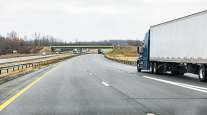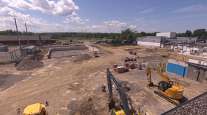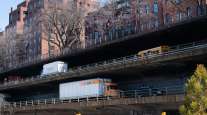Manhattan Drivers Could Be Facing $11.52 Toll to Drive City Streets

London did it. So did Singapore and Stockholm. Now New York may be coming around to congestion pricing.
The idea is gaining momentum in the state capital and at city hall, giving new urgency to a plan that would transform everyday life for millions of people by charging motorists an as-yet-undetermined toll — $11.52 according to past recommendations — to drive south of 61st Street in Manhattan.
Assembly Speaker Carl Heastie said March 27 that he has the votes to pass a bill, and Gov. Andrew Cuomo, a fellow Democrat, told WNYC radio he was fairly optimistic. “It’s proceeding,” he said, though “you’re not there until you’re there.”
Many in the New York City area would rather it never happen. But lawmakers are under pressure to take the step: They face an April 1 deadline on a budget vote that must include a way to finance $40 billion of capital improvements for the Metropolitan Transportation Authority, particularly for its century-old subways, which are plagued by equipment failures and breakdowns.

Governor Andrew Cuomo (Peter Foley/Bloomberg News)
What’s more, clogged midtown traffic is costing the city economy more than $9 billion a year in lost travel time, and $11 billion more in fuel, lost revenue and other costs, according to the Partnership for New York City, a civic group composed of CEOs.
Revenue from the tolls — which would be counted by electronic devices around Manhattan’s business core — would help the money-starved MTA bring subways up to 21st-century standards. The authority has estimated it needs $40 billion to do that over the next 10 years.
“I think we’re ready to move forward because the assembly members understand how important it is to fund the MTA,” Heastie said after a closed-door meeting with Democrats, who control the Legislature. “I wouldn’t say that if I didn’t think I had the votes.”
In the past, lawmakers representing the suburbs have objected to charging motorists to drive on many Manhattan streets, concerned for their constituents who already are paying to cross bridges into Manhattan. Many in the suburban bloc also had insisted that some congestion-toll funds go to support regional commuter trains.
Sen. James Skoufis, a Woodbury, Long Island Democrat, said he remains opposed, calling “double tolling” on bridge-and-tunnel motorists “just inherently unfair.”
Yet support now is broad enough for people to be “confident it will pass in the state budget,” said Gary Ginsburg, spokesman for Senate Majority Leader Andrea Stewart-Cousins.
Mayor Bill de Blasio has said he’s not about to wage war with his suburban neighbors about such issues. “I respect their concerns because they’re talking about mass transit for their communities,” he said earlier this month. “I am open to whatever gets us to a solution by April 1 — that’s the bottom line.”
The toll would raise about $1 billion a year, enough to finance $15 billion in bond issues toward transit improvements. The Legislature also is considering a pied-a-terre tax on nonresident-owned apartments worth more than $5 million, which would bring in about $650 million a year; that would be sufficient for about $9 billion in borrowing authority. An internet sales tax would produce an estimated $5 billion.
New York City Councilman Proposes Tolling All Entrances to the Cityhttps://t.co/Qy7RTL2GZO#TollRoadsNews #TRN #Transportation #Infrastructure #CongestionPricing #MTA — Toll Roads News (@tollroadsnews) March 27, 2019
Among the matters lawmakers still have to deal with is who to exempt from the tolls. Carve-outs caused problems in Stockholm, where revenue fell 14% short of projections due to so many exempted vehicles. Revenue also disappointed officials in London and Singapore when reduced traffic resulted in fewer motorists paying fees, according to Citizens Budget Commission data published March 19.
“It’s administratively cumbersome and a threat to revenue to carve out exemptions for the disabled or people traveling to medical appointments and other needs,” said Matthew Daus, a New York-based national transportation consultant who served as chairman of the city Taxi and Limousine Commission from 2001 to 2010. “Politicians tend to be more generous than they should in exempting people, and that can hurt the bottom line.”
For Cuomo, the bottom line is that without congestion pricing, the state-run MTA would have to increase subway and bus fares by 30%, jumping a single ride’s cost to more than $3 from $2.75 and a monthly pass to about $160 from its current $127.
“Either the rider pays in fares and tolls or it’s congestion pricing,” Cuomo said Feb. 7 as he tried to sell the plan to the Association for a Better New York, a business civic group. “That’s the real choice.”




